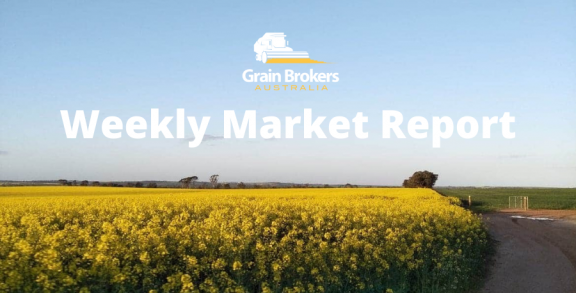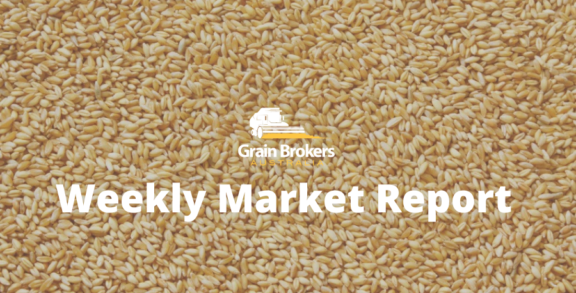
The rapidly deteriorating fate of the Canadian canola crop has pushed global values sharply higher over the last fortnight. The trade and global consumers are slowly coming to grips with the implications of a falling production outlook for the world’s largest producer and exporter of the oilseed.
Canadian farmers may have increased the area planted to canola from 8.32 million hectares in 2020 to 9.0 million hectares in 2021, but the yield projection is falling rapidly. Subsoil moisture was low from the outset across much of the Prairies after below-average rainfall over the last twelve months. The crop was sown into a good seedbed in most instances, but a dry spring and extreme temperatures are swiftly taking their toll.
In last week’s World Agricultural Supply and Demand Estimates (WASDE) report, the USDA pegged Canadian canola production at 20.2MMT down just 03.MMT from their June estimate. That is much higher than local trade estimates, most of which are under 19MMT. Some are already as low as 16MMT. As Mike Jubinville from MarketsFarm so fittingly stated last week, “In our view, the USDA is out to lunch on Canada.”
That statement could also be applied to the USDA’s throw at the dartboard for Australian canola production this season. They landed on 3.7MMT, up 0.2MMT on the June estimate, but well behind domestic ideas, many of which now exceed 5MMT. The Australia Oilseed Federation’s May crop report pegged the planted area at 2.87 million hectares, up 25 per cent on the 2020 area, and off which Australian farmers reaped a record 4.28MMT last harvest.
Since then, the growing conditions in the two major producing states of Western Australia and New South Wales have been exceptional. If anything, there may be some areas suffering from excessive moisture. However, production in those two states will be enormous, and the gains are more than making up for any losses in Victoria and South Australia, both of which have been on the dry side since planting.
Canada’s contribution to global supply is significant. A reduced crop in 2021 will have substantial ramifications for international trade and oilseed prices, as the market demonstrated in the first half of July. In the last five years, global canola exports have averaged 16.1 million metric tonnes (MMT). Over that same period, Canadian exports have averaged 10.32MMT, or 64.1 per cent of international trade.
This compares to Australia, the world’s second-largest exporter, which accounted for 14.7 per cent of average exports for the five years since 2016 and the world’s number three exporter Ukraine, at 13.7 per cent for the corresponding period. The world’s three largest exporters collectively accounted for an average of 92.5 per cent of global canola trade since 2016.
Over the last five years, the three major exporters have produced at least 25MMT of canola combined or more than 36 per cent of global production. The record season was 2017/18, where output was 27.5MMT in a year where global production exceeded 75MMT for the first and only time. The USDA is forecasting 74.14MMT in the 2021/22 season, but that will have to be revised downward in the coming months to reflect the Canadian situation.
Strong exports out of Canada in the first half of 2021 were already weighing on canola stocks before the production issues became evident. According to Agriculture and Agri-Food Canada, closing stocks for the 2020/21 season are forecast to be as low as 0.7MMT, implying an extremely tight stock-to-use ratio of less than 4 per cent.
The USDA currently has Canadian carry out for the 2021/22 season at 1.05MMT. This is based on exports of 10.1MMT, down from 10.5mmt, and domestic consumption of 10.35MMT, also down slightly from 10.56MMT in 2020/21. However, we know the USDA production number could be overstated by as much as 4.2MMT today. With no meaningful reprieve in sight to arrest the yield decline, exports will have to decrease to balance the equation.
The tightening supply situation pushed the November Canadian canola futures contract on the Intercontinental Exchange (ICE) to a record close of CAD916.80* per metric tonne on July 13, after trading as high as CAD949.00/mt in intraday trade. This is up from CAD771.40/mt a week earlier, a recent low of CAD666.40/mt on June 17, and CAD492.20/mt a year earlier. And there is plenty of talk of the CAD1,000/mt barrier being breached this week.
Price action in Europe was not as dramatic, but Paris MATIF futures did catch some of the rally, with the November contract closing at a season-high of €552.25/mt** on July 13, up from €503.50/mt a week earlier, €471/mt on June 17, and €369.50/mt on the same day in 2020.
This season could garner a rarely seen sweet spot for the Australian canola grower. They are witnessing record farm gate prices, and the production outlook is growing by the day with an excellent soil moisture profile across a majority of the planted area and an extremely favourable spring climate outlook.
New crop domestic grower bids smashed through the AUD800/mt mark Friday week ago in Western Australia and closed last Friday at a mouth-watering AUD860/mt. It is fair to say that the west coast grower has probably sold more tonnes at this point in the season than ever before, but in terms of a proportion of a growing crop, it is probably at, or slightly behind, the long term average.
The east coast grower is also excited about the potential return on investment outcome that a high price and above-average production scenario could yield. Newcastle, Port Kembla, and Geelong grower bids all finished the week at around AUD806/mt, and the Port Adelaide number closed a tad higher at $810/mt. Grower selling has been steady, but that will undoubtedly accelerate as production certainty builds heading into the spring.
A key question for domestic canola values will revolve around the EU consumer reaction to lower Canadian production and exports. The trading bloc is the fourth biggest importer of Canadian canola behind China, Japan and Mexico. They will need to compete with those destinations to lock in supply. However, they are also likely to compete heavily to buy a bigger portion of the growing Australian export pie away from traditional Asian destinations.
* AUD/CAD exchange rate on July 19: 0.9334
** AUD/EUR exchange rate on July 19: 0.6265
Call your local Grain Brokers Australia representative on 1300 946 544 to discuss your grain marketing needs.





